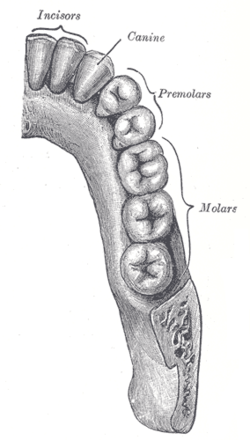Incisor
| Incisor | |
|---|---|
 Permanent teeth of right half of lower dental arch, seen from above. | |
 The permanent teeth, viewed from the right. | |
| Details | |
| Identifiers | |
| Latin | dens incisivus |
| MeSH | D007180 |
| TA | A05.1.03.004 |
| FMA | 12823 |
Anatomical terminology [edit on Wikidata] | |
Incisors (from Latin incidere, "to cut") are the front teeth present in most mammals. They are located in the premaxilla above and on the mandible below. Humans have a total of eight (two on each side, top and bottom). Opossums have 18, whereas armadillos have none.[1]
Contents
1 Structure
1.1 Other animals
2 Function
3 Additional images
4 See also
5 References
6 External links
Structure
Adult humans normally have eight incisors, two of each type. The types of incisor are:
maxillary central incisor (upper jaw, closest to the center of the lips)
maxillary lateral incisor (upper jaw, beside the maxillary central incisor)
mandibular central incisor (lower jaw, closest to the center of the lips)
mandibular lateral incisor (lower jaw, beside the mandibular central incisor)
Children with a full set of deciduous teeth (primary teeth) also have eight incisors, named the same way as in permanent teeth. Young children may have from zero to eight incisors depending on the stage of their tooth eruption and tooth development. Typically, the mandibular central incisors erupt first, followed by the maxillary central incisors, the mandibular lateral incisors and finally the maxillary laterals. The rest of the primary dentition erupts after the incisors.[2]
Apart from the first molars, the incisors are also the first permanent teeth to erupt, following the same order as the primary teeth, among themselves.
Other animals
Among other animals, the number varies from species to species. Opossums have 18, whereas armadillos have none. Cats, dogs, foxes, pigs, and horses have twelve. Rodents have four. Rabbits and hares (lagomorphs) were once considered rodents, but are distinguished by having six—one small pair, called "peg teeth", is located directly behind the most anterior pair. Incisors are used to bite off tough foods, such as red meat.
Cattle (cows, bulls, etc.) have none on top but a total of six on the bottom.
Function
In cats, the incisors are small; biting off meat is done with the canines and the carnassials. In elephants, the upper incisors are modified into curved tusks (unlike with Narwhals, where it is a canine that develops into a straight and twisted tusk).[3] The incisors of rodents grow throughout life and are worn by gnawing. In humans, the incisors serve to cut off pieces of food, as well as in the grip of other food items.
Additional images

Medical animation showing Incisor teeth and its arrangement in the mouth of an adult human being.

Mouth (oral cavity)

Left maxilla. Outer surface.

Base of skull. Inferior surface.
See also
- Canine tooth
- Molar
- Premolar
- Shovel-shaped incisors
References
^ "Archives". dentalcare.com. Archived from the original on 29 April 2018. Retrieved 29 April 2018..mw-parser-output cite.citationfont-style:inherit.mw-parser-output qquotes:"""""""'""'".mw-parser-output code.cs1-codecolor:inherit;background:inherit;border:inherit;padding:inherit.mw-parser-output .cs1-lock-free abackground:url("//upload.wikimedia.org/wikipedia/commons/thumb/6/65/Lock-green.svg/9px-Lock-green.svg.png")no-repeat;background-position:right .1em center.mw-parser-output .cs1-lock-limited a,.mw-parser-output .cs1-lock-registration abackground:url("//upload.wikimedia.org/wikipedia/commons/thumb/d/d6/Lock-gray-alt-2.svg/9px-Lock-gray-alt-2.svg.png")no-repeat;background-position:right .1em center.mw-parser-output .cs1-lock-subscription abackground:url("//upload.wikimedia.org/wikipedia/commons/thumb/a/aa/Lock-red-alt-2.svg/9px-Lock-red-alt-2.svg.png")no-repeat;background-position:right .1em center.mw-parser-output .cs1-subscription,.mw-parser-output .cs1-registrationcolor:#555.mw-parser-output .cs1-subscription span,.mw-parser-output .cs1-registration spanborder-bottom:1px dotted;cursor:help.mw-parser-output .cs1-hidden-errordisplay:none;font-size:100%.mw-parser-output .cs1-visible-errorfont-size:100%.mw-parser-output .cs1-subscription,.mw-parser-output .cs1-registration,.mw-parser-output .cs1-formatfont-size:95%.mw-parser-output .cs1-kern-left,.mw-parser-output .cs1-kern-wl-leftpadding-left:0.2em.mw-parser-output .cs1-kern-right,.mw-parser-output .cs1-kern-wl-rightpadding-right:0.2em
^ Scheid, RC. (2012). Woelfel's dental anatomy (8 ed.). Philadelphia: Wolters Kluwer Health/Lippincott Williams & Wilkins.
^ Nweeia, Martin; Eichmiller, Frederick C.; Hauschka, Peter V.; Tyler, Ethan; Mead, James G.; Potter, Charles W.; Angnatsiak, David P.; Richard, Pierre R.; et al. (30 March 2012). "Vestigial Tooth Anatomy and Tusk Nomenclature for Monodon Monoceros". The Anatomical Record. 295 (6): 1006–1016. doi:10.1002/ar.22449. PMID 22467529.
External links
 Media related to Incisors at Wikimedia Commons
Media related to Incisors at Wikimedia Commons




